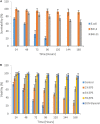A Glacier Bacterium Produces High Yield of Cryoprotective Exopolysaccharide
- PMID: 32117080
- PMCID: PMC7026135
- DOI: 10.3389/fmicb.2019.03096
A Glacier Bacterium Produces High Yield of Cryoprotective Exopolysaccharide
Abstract
Pseudomonas sp. BGI-2 is a psychrotrophic bacterium isolated from the ice sample collected from Batura glacier, Pakistan. This strain produces highly viscous colonies on agar media supplemented with glucose. In this study, we have optimized growth and production of exopolysaccharide (EPS) by the cold-adapted Pseudomonas sp. BGI-2 using different nutritional and environmental conditions. Pseudomonas sp. BGI-2 is able to grow in a wide range of temperatures (4-35°C), pH (5-11), and salt concentrations (1-5%). Carbon utilization for growth and EPS production was extensively studied and we found that glucose, galactose, mannose, mannitol, and glycerol are the preferable carbon sources. The strain is also able to use sugar waste molasses as a growth substrate, an alternative for the relatively expensive sugars for large scale EPS production. Maximum EPS production was observed at 15°C, pH 6, NaCl (10 g L-1), glucose as carbon source (100 g L-1), yeast extract as nitrogen source (10 g L-1), and glucose/yeast extract ratio (10/1). Under optimized conditions, EPS production was 2.01 g L-1, which is relatively high for a Pseudomonas species compared to previous studies using the same method for quantification. High-performance anion-exchange chromatography with pulsed amperometric detection (HPAEC-PAD) analysis of EPS revealed glucose, galactose, and glucosamine as the main sugar monomers. Membrane protection assay using human RBCs revealed significant reduction in cell lysis (∼50%) in the presence of EPS, suggesting its role in membrane protection. The EPS (5%) also conferred significant cryoprotection for a mesophilic Escherichia coli k12 which was comparable to glycerol (20%). Also, improvement in lipid peroxidation inhibition (in vitro) resulted when lipids from the E. coli was pretreated with EPS. Increased EPS production at low temperatures, freeze thaw tolerance of the EPS producing strain, and increased survivability of E. coli in the presence of EPS as cryoprotective agent supports the hypothesis that EPS production is a strategy for survival in extremely cold environments such as the glacier ice.
Keywords: Karakoram; cryopreservation; exopolysaccharide; glacier bacteria; psychrotrophs.
Copyright © 2020 Ali, Shah, Hasan, Hertkorn, Gonsior, Sajjad and Chen.
Figures





References
-
- Aslam S. N., Cresswell−Maynard T., Thomas D. N., Underwood G. J. (2012). Production and characterization of the intra−and extracellular carbohydrates and polymeric substances (EPS) of three sea−ice diatom species, and evidence for a cryoprotective role for EPS. J. Phycol. 48 1494–1509. 10.1111/jpy.12004 - DOI - PubMed
LinkOut - more resources
Full Text Sources
Molecular Biology Databases

